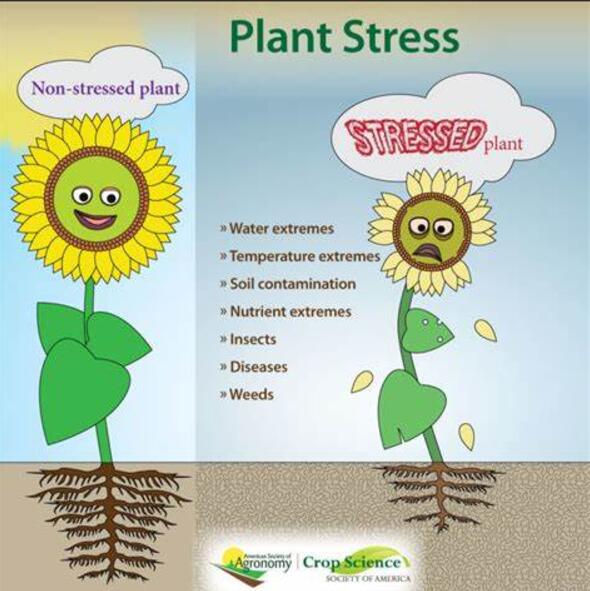Metabolomic and transcriptomic analyses reveal MYB-Related genes involved in drought resistance in grafted potatoes via the flavonoid pathway
IF 6.8
Q1 PLANT SCIENCES
引用次数: 0
Abstract
Drought poses a significant challenge to global potato production. Grafting, a classical horticultural technique, has the potential to enhance resistance to both biotic and abiotic stresses. However, the use of grafting to improve drought resistance in potatoes, along with the underlying genetic and regulatory changes remains inadequately documented. In this study, we investigated the drought phenotypes, as well as the metabolomic and transcriptomic profiles of leaves and roots in self-grafted (drought-sensitive scion/ drought-sensitive rootstock, SS) and hetero-grafted (drought-sensitive scion/drought-tolerant rootstock, ST) potatoes. After 40 days, hetero-grafts exhibited greater drought resistance as well as lower dry matter content and higher soluble sugar content compared to self-grafts, indicating that grafting with drought-tolerant rootstocks can enhance the drought resistance of the scion and revealed physiological process. Metabolomic analysis revealed a significant enrichment of flavonoids, particularly in comparisons between SS-leaf vs. ST-leaf and SS-root vs. ST-root. Transcriptomic analysis further supported these findings, showing an enrichment in the biosynthesis of plant secondary metabolites in the same comparisons, aligning with metabolomic data. These differentially accumulated metabolites and expressed genes, particularly in SS-leaf vs. ST-leaf comparison, suggest a mechanism involving long-distance metabolites and mRNA in grafting-mediated drought resistance. Weighted Gene Co-expression Network Analysis identified the yellow module, which correlated with drought, and highlighted MYB or MYB-related genes as hub genes. Our results reveal global metabolomic and transcriptomic features associated with drought tolerance in potatoes, demonstrating that grafting can alter the composition and accumulation of genes and metabolites, leading to enhanced drought resistance. The significant role of flavonoids as modulators of drought resistance, supported by comprehensive transcriptomic and metabolomic analyses, underscores the pivotal regulatory function of the MYB-WD40-bHLH transcription factor complex in orchestrating the stress response.
代谢组和转录组分析揭示了通过类黄酮途径参与嫁接马铃薯抗旱的 MYB 相关基因
干旱对全球马铃薯生产构成重大挑战。嫁接作为一种经典的园艺技术,具有增强对生物和非生物胁迫的抗性的潜力。然而,利用嫁接来提高马铃薯的抗旱性,以及潜在的遗传和调控变化仍然没有得到充分的记录。在本研究中,我们研究了自嫁接(干旱敏感接穗/干旱敏感砧木,SS)和异质嫁接(干旱敏感接穗/耐旱砧木,ST)马铃薯的干旱表型以及叶片和根部的代谢组和转录组图谱。40 天后,异株嫁接的马铃薯与自株嫁接的马铃薯相比表现出更强的抗旱性、更低的干物质含量和更高的可溶性糖含量,这表明与耐旱砧木嫁接可增强接穗的抗旱性,并揭示了生理过程。代谢组分析表明,黄酮类化合物含量显著增加,特别是在 SS-叶与 ST-叶、SS-根与 ST-根的比较中。转录组分析进一步支持了这些发现,显示在相同的比较中,植物次生代谢物的生物合成丰富,与代谢组数据一致。这些不同积累的代谢物和表达基因,尤其是在 SS 叶与 ST 叶的比较中,表明嫁接介导的抗旱机制涉及长距离代谢物和 mRNA。加权基因共表达网络分析确定了与干旱相关的黄色模块,并突出了作为枢纽基因的 MYB 或 MYB 相关基因。我们的研究结果揭示了与马铃薯抗旱性相关的全局代谢组学和转录组学特征,表明嫁接可以改变基因和代谢产物的组成和积累,从而增强抗旱性。在全面的转录组和代谢组分析的支持下,类黄酮作为抗旱性调节因子的重要作用凸显了 MYB-WD40-bHLH 转录因子复合物在协调胁迫响应中的关键调控功能。
本文章由计算机程序翻译,如有差异,请以英文原文为准。
求助全文
约1分钟内获得全文
求助全文
来源期刊

Plant Stress
PLANT SCIENCES-
CiteScore
5.20
自引率
8.00%
发文量
76
审稿时长
63 days
期刊介绍:
The journal Plant Stress deals with plant (or other photoautotrophs, such as algae, cyanobacteria and lichens) responses to abiotic and biotic stress factors that can result in limited growth and productivity. Such responses can be analyzed and described at a physiological, biochemical and molecular level. Experimental approaches/technologies aiming to improve growth and productivity with a potential for downstream validation under stress conditions will also be considered. Both fundamental and applied research manuscripts are welcome, provided that clear mechanistic hypotheses are made and descriptive approaches are avoided. In addition, high-quality review articles will also be considered, provided they follow a critical approach and stimulate thought for future research avenues.
Plant Stress welcomes high-quality manuscripts related (but not limited) to interactions between plants and:
Lack of water (drought) and excess (flooding),
Salinity stress,
Elevated temperature and/or low temperature (chilling and freezing),
Hypoxia and/or anoxia,
Mineral nutrient excess and/or deficiency,
Heavy metals and/or metalloids,
Plant priming (chemical, biological, physiological, nanomaterial, biostimulant) approaches for improved stress protection,
Viral, phytoplasma, bacterial and fungal plant-pathogen interactions.
The journal welcomes basic and applied research articles, as well as review articles and short communications. All submitted manuscripts will be subject to a thorough peer-reviewing process.
 求助内容:
求助内容: 应助结果提醒方式:
应助结果提醒方式:


